How to Continue After Elite Four in Pokemon Fire Red
From Bulbapedia, the community-driven Pokémon encyclopedia.
- FireRed and LeafGreen redirects here. For the Pokémon Trading Card Game expansion, see EX FireRed & LeafGreen (TCG).
| ||||||||||||||||||||||||||||||||||||||||||||||||
| ||||||||||||||||||||||||||||||||||||||||||||||||
| ||||||||||||||||||||||||||||||||||||||||||||||||
| ||||||||||||||||||||||||||||||||||||||||||||||||
| ||||||||||||||||||||||||||||||||||||||||||||||||
| ||||||||||||||||||||||||||||||||||||||||||||||||
| ||||||||||||||||||||||||||||||||||||||||||||||||
| ||||||||||||||||||||||||||||||||||||||||||||||||
Pokémon FireRed Version (Japanese: ポケットモンスターファイアレッド Pocket Monsters Firered [4]) and Pokémon LeafGreen Version (Japanese: ポケットモンスターリーフグリーン Pocket Monsters Leafgreen [4]) are a pair of core series Generation III games that are set in the Kanto region. They were released in Japan on January 29, 2004, in North America on September 9, 2004, in Australia on September 23, 2004 and in Europe on October 1, 2004.
As the first remakes in the Pokémon franchise, the games revisit the original pair of Pokémon games, Pokémon Red and Green Versions. The remakes feature the characters, plot elements, and challenges from the originals, along with several updates introduced in Generation III.
The Game Boy Advance Wireless Adapter was initially included with the games when they were first released, eliminating the need for Game Link Cables when trading between the two games (and later Pokémon Emerald). In later copies, it was sold separately.
FireRed and LeafGreen went on to become the second best-selling games on the Game Boy Advance, only behind Pokémon Ruby and Sapphire. They also received Nintendo's Player's Choice awards.
FireRed and LeafGreen are the first of two remakes to take place in the region of Kanto, and were followed by Generation VII games Pokémon: Let's Go, Pikachu! and Let's Go, Eevee! in 2018.
Plot
The plot follows the same storyline as Generation I, with the player beginning in Pallet Town. After meeting up with Professor Oak while trying to leave for Route 1, both the player and their rival are asked by Oak to choose a starter Pokémon, Bulbasaur, Charmander, or Squirtle, from the desk near him. Oak allows the player to choose first and the rival quickly gets jealous, chooses the starter whose type is super-effective against the player's starter, then challenges the player to a battle. During this battle, Professor Oak commentates.
After the battle, Oak allows the two new Trainers to leave for their journey across Kanto. Stopping in Viridian City's Poké Mart, the player will find that a package has come in for the professor, and the clerk asks that it be delivered to him. After this has been completed the professor gives one Pokédex to the player and one to the rival, and sends them on their way. Viridian City has a Gym; however, it is locked.
From here, the player has their first encounter with other Trainers, on Route 2 and in Viridian Forest, and their first encounter with a Gym Leader: Brock the Rock-type Gym Leader of Pewter City. After his defeat, journeying along Route 3 and through Mt. Moon brings the player face to face with the regional villainous team, Team Rocket, who are attempting to extract rare Fossils from the cave. Their defeat allows the player to continue through the cave, obtain the Dome Fossil or Helix Fossil which can be regenerated into Kabuto and Omanyte, and continue onto Route 4, which leads directly into Cerulean City, where another Gym is. This one, however, is run by Misty, and specializes in Water-type Pokémon. To the north, as well, there are two routes leading up to Bill's cottage. On the way, the player is confronted with a trainer who tries to persuade them to join Team Rocket. When the player reaches Bill's cottage and frees him of his transformation into a Clefairy, he will give the player a ticket for the S.S. Anne, a luxury ship moored in Vermilion Harbor and filled with Trainers. Taking a shortcut through a house burglarized by Team Rocket, the player finally arrives at Route 5.
After traveling down Routes 5 and 6, using the Underground Path to bypass Saffron City, the player finally arrives in Vermilion. This city is home to another Pokémon Gym; however, the way to it is blocked by a small tree. The only thing to do is to show the ticket to the Sailor guarding the harbor, allowing entry into the S.S. Anne. It is here, after assisting the captain with his seasickness, that the player will obtain the first of the seven Hidden Machines available in the game, containing Cut. With this, and the Cascade Badge, the tree blocking the way to Vermilion Gym can be easily cut through, and Lt. Surge, a Gym Leader specializing in Electric-types, can be challenged. From here, Route 11 beckons, as does Diglett's Cave, through which is the only way to get back to Route 2, and a second HM, containing Flash held by one of Professor Oak's aides on Route 2. The player takes a brief detour to Pewter City's museum's back entrance which was previously blocked due to a Cut-able tree, which can now easily be bypassed. The player obtains the Old Amber in the museum. Heading back to Diglett's Cave, and to Vermilion, the player must go to Cerulean and to the east, onto Route 9 and towards the Rock Tunnel.
Rock Tunnel, a still undeveloped natural tunnel between the sections of Route 10, is pitch black inside; for this reason, Flash is recommended, but not required, for navigation of it. Finally reaching Lavender Town, the only town in Kanto without a Pokémon Gym besides Pallet, there is not much to do; the local Pokémon Tower is haunted. From here, Route 8 leads to Saffron City, but it again must be bypassed by way of another Underground Path, which has its other entrance on Route 7, on the west side of Saffron. Celadon City, the home of the fourth Gym which specializes in Grass-type Pokémon, is just a short walk further. Like the Vermilion Gym, the Celadon Gym also has a small tree blocking the way to its entrance, and an old man outside.
The Rocket Game Corner in Celadon is not what it appears to be. In fact, the Game Corner itself is merely the above-ground portion of a sprawling underground complex: the Rocket Hideout. The Team Rocket boss, Giovanni, appears for the first time here, and after his defeat, flees, leaving behind a Silph Scope. A Silph Scope is required to fully navigate the Pokémon Tower inside of Lavender Town that the player encountered earlier.
After this, the Pokémon Tower can be navigated, and the ghosts haunting it are revealed to be Gastly and Haunter. In front of the stairs to the final floor, blocking the way, is also a final spirit, that of a deceased Marowak that was killed by Team Rocket when they captured her child. Making it all the way to the top reveals Mr. Fuji held hostage by Team Rocket grunts, who will leave when they are defeated. Fuji gives away the Poké Flute, and with that, the Snorlax blocking Route 11 and Route 16 can finally be moved away. Another HM, containing Fly, can be obtained easily by cutting away a tree blocking the northern section of Route 16.
Now the player is presented with a choice of how to get to Fuchsia City. Traveling down either way the Snorlax are blocking, a faster way via Routes 16, 17, and 18 on Cycling Road, or down the Silence Bridge of Routes 12, 13, 14, and 15, inevitably brings one to the southernmost city in continental Kanto, Fuchsia City, home of Koga of the Poisonous Fuchsia Gym and the Kanto Safari Zone. The Safari Zone is currently running a contest: the person to reach a specific rest house first will win yet another HM, containing Surf. Finding the Safari Zone Warden's Gold Teeth also will have him reward the player with the final of Kanto's HMs, containing Strength.
The player then goes back to either Celadon City or Lavender Town, encountering the other Snorlax on the way back. After stopping off at the Celadon Mansion and getting some Tea, Saffron City can finally be entered. However, Team Rocket is guarding almost every door in the city, including that of the local Pokémon Gym! One of the open buildings, however, is the unofficial Fighting-type Pokémon Gym. After the player defeats the Fighting Dojo, they are entitled to either a Hitmonchan or a Hitmonlee. The city's centerpiece building, Silph Co.'s headquarters, has also been infiltrated by the organization, and at the top, waiting in the boardroom, is the Team Rocket Boss, Giovanni, appearing for a second time, demanding that the president give him the Master Ball that the company had developed. After his defeat, he flees.
After Team Rocket clears out of Saffron City, all buildings previously blocked are now open, as well as the Gym. The Gym Leader, Sabrina, specializes in Psychic-types. The floor, as well, is covered in warp tiles that make it difficult to navigate. After Sabrina's defeat, the player makes their way back to Fuchsia City again and heads out to obtain the rest of the Badges.
With six Badges in hand, and five HMs in the TM Case, finally the player can adventure onto the open sea of Routes 19 and 20. A short way across them, of course, is a minor obstacle: the Seafoam Islands. After they have been navigated through, the player can continue on Route 20 to Cinnabar Island, home of Blaine's Fire-type Gym. There are also several more facilities on the island, including one that actually revives Pokémon Fossils. After Blaine's defeat, Bill shows up again, because he needs help in a small region south of Kanto, the Sevii Islands. If the player accepts, the Seagallop Ferry will travel to One Island, where a friend of Bill's, Celio, is attempting to connect the islands' PC system to that of Kanto. During this, there is also a crisis in Two Island, where the daughter of the owner of the Joyful Game Corner has gone missing, and in Three Island where a group of invading Bikers are causing trouble. After defeating them and finding the lost girl, Lostelle, who is in Berry Forest, Bill and the player will return to Kanto, where the final Gym, that of Viridian City, lies.
Finally unlocked, the Gym, whose leader specializes in Ground-types, is revealed to be none other than the boss of Team Rocket himself, Giovanni! After his defeat, he vows to disband Team Rocket and disappears. Now with eight Badges, all that lies ahead is the Pokémon League at Indigo Plateau, conveniently at the end of Route 23.
The Elite Four await challengers, those who have proven themselves worthy by getting all eight Badges and making it through Victory Road will face them, in order. Lorelei, who trains Ice-type Pokémon is first, followed by Bruno, whose specialty is Fighting, Agatha, whose specialty is Ghost, and finally Lance, who specializes in Dragon-types. After defeating these four, the reigning Pokémon Champion challenges the player to a final battle, and the Champion is none other than the player's own rival! After his defeat, Oak arrives and tells the player that they won because they care better for their Pokémon, and the player's current party are added to the Hall of Fame.
Post-game
After the credits roll, the player is back in Pallet Town. Professor Oak will have the player come to his lab to check on the Pokédex. If the player has obtained at least 60 Pokémon he will then upgrade it to the National Pokédex and ask the player to go back to the Sevii Islands to encounter Pokémon that Professor Oak has never before seen.
There is some more work that Celio needs to do on his network machine, as he wishes to link to yet another region. The signal, however, is not strong enough, and he needs the Ruby and the Sapphire, two items found in the Sevii Islands, to strengthen it. The Ruby is found deep in a cave in Mt. Ember, which Team Rocket grunts have been seen fooling around with. The Sapphire lies at the deepest part of the Dotted Hole in Ruin Valley. The Ruby can be given to Celio without a hitch; however, the Sapphire, when found, is stolen by a Scientist named Gideon, who takes it back to Team Rocket's warehouse in the Five Isle Meadow. By infiltrating the warehouse and defeating the remaining Rocket Admins, they realize that Giovanni has disbanded Team Rocket. They do, however, vow to return one day, and bring Team Rocket back to its former glory. Gideon reluctantly gives back the Sapphire, and after this, trades are possible with the Hoenn-based Pokémon Ruby, Sapphire, and Emerald. The Elite Four can once again be challenged, and their Pokémon are 12 levels higher, with some of them possessing new Pokémon. In addition, Cerulean Cave is now open, and the powerful Mewtwo can be found there. Entei, Suicune, or Raikou will also begin roaming the Kanto region, depending on whether the player chose Bulbasaur, Charmander, or Squirtle, respectively, as their starter Pokémon.
Blurb
Set off on a grand adventure to fulfill your dreams of becoming a Pokémon Master! Explore the Kanto region and discover wild Pokémon around every corner. Build your Pokémon collection and train and battle your way to success—earn your badges as you develop winning strategies to use against experienced Gym Leaders in every town. Explore every inch to uncover amazing secrets that will help you in your quest to be the very best trainer ever!
- Trade, battle, and chat wirelessly! All new Wireless Adapter comes packed in every game, so trainers can trade, battle, and chat between their FireRed and LeafGreen versions with no cables!
- Catch loads of Pokémon in never-before-seen island areas!
- Expand your collection when you trade with a friend. Link up with Pokémon Ruby and Sapphire or Pokémon Colosseum to catch them all!
Changes from Pokémon Red and Green
Gameplay
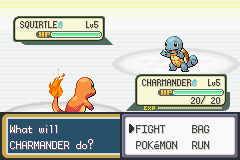
- Players can now play as a female character as an alternative to the male character, which was the only option in Generation I.
- A resume feature was introduced, allowing players to remember the four most important events they achieved in the games the last time they were played. After entering the Hall of Fame, the resume feature displays the last four notable things the player has done recently instead of showing a specific event.
- A game introduction feature, which explains the controls of the game, was added. This feature continued to appear in all games in Generation IV.
- The Help System was added, which can be activated by pressing the L or R buttons on the console. There is also another help feature in the form of the Teachy TV, which is given by an old man in Viridian City.
- A new southern region, the Sevii Islands, is accessible, where Generation II Pokémon can be caught. Notably, most of these Pokémon cannot be found in Pokémon Ruby, Sapphire, and Emerald.
- Bite, Sand-Attack, Karate Chop, and Gust have changed types.
- Team Rocket has an expanded role in the game's post-game storyline, with a new base in the Sevii Islands.
- Pokémon can breed in the Pokémon Day Care in Four Island. The daycare on Route 5 remains, but it is still limited to only caring for one Pokémon at a time.
- The Ability Pickup has been modified from Ruby and Sapphire, which also includes that some of the Berries from those versions can be picked up in FireRed and LeafGreen. This is due to the inability to grow Berries in Kanto. The other Berries can only be collected by trading Pokémon from those versions as well as Emerald.
- A man is present in a house in Cerulean City and will help create Berry Powder via Berry Crush. This powder can then be exchanged for rare and valuable items.
- Trainers outdoors can be rebattled using the Vs. Seeker.
- Information on major characters, such as Gym Leaders, is recorded in the Fame Checker.
- Three additional aides for Professor Oak have been added to reward the player with items that were introduced in Generations II and III, while a returning aide now gives out the Exp. Share, the upgraded version of the Generation I item Exp. All.
- Pokémon movelists are updated to include moves introduced in Generation II and Generation III.
- The TM list is shared with other Generation III games. In addition, Move Tutors become available to teach moves formerly contained in Generation I TMs.
- The Elite Four and Champion can be rebattled, and acquire Generation II Pokémon on their teams after the Sevii Islands quest has been completed.
- Blast Burn, Frenzy Plant, and Hydro Cannon are available as Move Tutor moves at Cape Brink on Two Island. They can only be taught to the final evolved form of the player's starter Pokémon, or other members of that same species.
- There is a new minigame corner, the Joyful Game Corner, on Two Island, where players can connect together, along with Emerald, and can play multiplayer minigames (Pokémon Jump and Dodrio Berry Picking) over the wireless communication system. This feature becomes usable after the events at Three Island.
- Cerulean Cave in these games is very similar to the one in Red and Green. The only difference is the Generation III addition of breakable rocks.
Pokémon
- As in all Generation III games, Pokémon now have natures, Abilities, and genders, and can hold items.
- Magnemite and Magneton now are Electric/Steel, as they have been since Generation II. In the original Red and Green games, they were pure Electric-type.
- Pokémon retain their Generation II and III evolutionary lines (e.g. Golbat can evolve into Crobat), but cannot evolve into these new stages until after the player has obtained the National Pokédex. Eevee is the only exception to this, since Espeon and Umbreon cannot be obtained due to the lack of a clock system in the game, and trading between the other Generation III games is required to obtain them.
- Magmar (LeafGreen only) and Ponyta have been moved to new locations. Ponyta is now located on One Island's Kindle Road, and Magmar is now at Mt. Ember. In Generation I, they were both found in the Pokémon Mansion on Cinnabar Island.
- Deoxys debuts two new forms: Attack Forme (FireRed) and Defense Forme (LeafGreen), which appear exclusively in the respective games.
- Moltres has moved from its original location in Victory Road to Mt. Ember. Cerulean Cave, where Mewtwo resides, now requires Rock Smash for navigation, and it cannot be entered until after the post-game mission in the Sevii Islands has been completed.
- One of Johto's legendary beasts (Raikou, Entei, or Suicune) will roam around Kanto after completing the Network Machine quest on the Sevii Islands during the post-game. The beast that appears is the one that has a type advantage over the player's starter Pokémon.
- Version-exclusive Pokémon and wild Pokémon distribution have been altered from the original games to account for new evolutions released in Generation II.
- Mankey and Meowth, originally Version-exclusive, are now available in both games, while Psyduck, Shellder, Slowpoke, and Staryu have become Version exclusives. Due to this change, Lickitung, which was originally available through an in-game trade by trading Slowbro in both Red and Blue, now is traded for Golduck in FireRed or Slowbro in LeafGreen.
Version-exclusive Pokémon
The following Pokémon are only obtainable in one game of this pair. In order to obtain Pokémon exclusive to the other game of this pair, they must be traded either from that game or from another compatible game of Generation III which has that Pokémon available. In addition, Mew, several Generation II Pokémon and all Generation III Pokémon (except Azurill, Wynaut, and Deoxys) must be traded from a Hoenn-based game.
|
| |||||||||||||||||||||||||||||||||||||||||||||||||||||||||||||||||||||||||||||||||||||||||||||||||||||||||||||||||||||||||||||||||||||||||||||||||||||||||||||||||||||||||||||||||||||||||||||||||||||||||||||||||||||||||||||||||||||||||||||||
Graphics
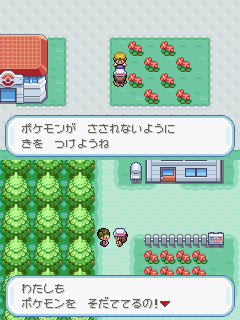
Japanese version font difference
Top: male NPC, bottom: female NPC
Note the common word ポケモン (Pokémon)
- Dialogue text is rendered differently based on the gender of the non-player characters.
- In the Japanese versions, male NPCs are given a computer-style font while female NPCs show a font that resembles handwritten text. Text from other sources uses the same font as male NPCs.
- In non-Japanese versions, the differentiation is instead done with colors: male NPCs use blue text and female NPCs use pink text. Text from other sources is black.
- When entering certain locations such as Viridian Forest or Diglett's Cave, an image of the location appears.
- A few scenes have been fixed.
- Professor Oak now walks over to the table and gives the player and rival their Pokédexes. In Generation I, the Pokédex sprites would instead vanish after the game says that the player obtained it without anyone having moved.
- The boy who prevents the player from leaving Pewter City before Brock is defeated (by escorting the player to the Gym) now returns the way he came. In Generation I, he would instead walk east and vanish offscreen, where a barrier prevents the player from walking.
- Pokémon FireRed and LeafGreen are the first games of the core series where each item has its own sprite; the sprites can be seen from the player's Bag. These images were retained in Pokémon Emerald as well as later generations.
- In particular, all the items previously introduced in Pokémon Ruby and Sapphire also had their sprites introduced in the game data of FireRed and LeafGreen, except the e-Reader exclusive Berries (Drash Berry, Eggant Berry, Nutpea Berry, etc.). Some of these items (such as the Acro Bike, Mach Bike, Contest Pass, Go-Goggles, Eon Ticket, etc.) are not legitimately found in FireRed and LeafGreen, so their sprites remained unseen in normal gameplay until they were reused in Pokémon Emerald.
Music
- The music has been remixed to take advantage of the Game Boy Advance's power.
- Most of the themes remain the same, with some exceptions listed below.
- In Generation I, the Power Plant used the Rocket Hideout theme. In FireRed and LeafGreen, the Power Plant uses the Pokémon Mansion theme.
- In Generation I, the standard Trainer battle music was used for the three Elite Four members other than Lance, which used the Gym Leader battle theme. In FireRed and LeafGreen, the Gym Leader background music is used for all four members.
- In Generation I, when Professor Oak congratulates the player after becoming the Pokémon League Champion, a slower version of the theme from Viridian City, Pewter City, and Saffron City played. In FireRed and LeafGreen, a happier-toned version of the Pallet Town background music plays at this point instead.
- Some places in the Sevii Islands use remixed versions of Johto music themes from Gold, Silver, and Crystal.
- The towns of Four Island and Five Island use the theme from Azalea Town and Blackthorn City.
- The towns of Six Island and Seven Island use the theme from Violet City and Olivine City.
Connectivity
FireRed and LeafGreen were created as a result of the first Generation III games, Pokémon Ruby and Sapphire, lacking backward compatibility with Generations I and II. Trading between these games and the third Hoenn-based game, Pokémon Emerald, is possible through the traditional Game Link Cable. Trading with other copies of FireRed or LeafGreen as well as with Emerald may also be done through the GBA Wireless Adapter, though Ruby and Sapphire are not compatible with it. Using a GameCube-GBA cable, players may also trade party Pokémon with Pokémon Colosseum and Pokémon XD, but only after the player has obtained the Ruby and Sapphire and given them to Celio.
While FireRed and LeafGreen cannot trade directly with the Generation IV games Pokémon Diamond, Pearl, Platinum, HeartGold, and SoulSilver, a player's Pokémon may be permanently transferred via Pal Park, and some Generation I Pokémon can be found using dual-slot mode.
Reception
The games were praised by critics for maintaining the same storyline as the original versions, and also for incorporating new events. Criticism was received, however, for the lack of graphical improvement from Ruby and Sapphire.[5] Generally, the games scored highly.[6] [7] Nintendo Power magazine gave them 4.5/5,[8] while IGN rated the games an "Amazing" 9.0/10.[5] Eurogamer, though, criticized the lack of 'evolution' from the series, giving the remakes a 7/10.[9] Gaming magazine Famitsu gave the games a score of 33 out of 40. Pokémon FireRed and LeafGreen hold a rating of 81.92%[10] and 80.78%,[11] respectively, on GameRankings.
Sales
FireRed and LeafGreen received strong sales, although weaker than Ruby and Sapphire. Over one million copies were sold in Japan over the first four days of release.[12] In the fiscal year of their release, they sold more than 2 million units.[13] As of March 31, 2013, Pokémon FireRed and LeafGreen have sold 12 million copies worldwide making these the lowest selling remakes of core series games.[14]
Japanese sales
Pokémon FireRed and LeafGreen sold 1,013,119 units on their first week on the Japanese market, being 517,874 from Pokémon FireRed and 495,245 from Pokémon LeafGreen, with a sell-through of 96.01% and 92.40% respectively. By January 2, 2011, the end of their 362nd week, they had sold 2,909,961 copies, being 1,619,109 from Pokémon FireRed and 1,290,852 from Pokémon LeafGreen.
| Pokémon FireRed Version
| Pokémon LeafGreen Version
| ||||||||||||||||||||||||||||||||||||||||||||||||||||||||||||||||||||||||||||||||||||||||||||||||||||||||||||||
Staff
- Main article: Staff of Pokémon FireRed and LeafGreen
Music
- Main article: Pokémon FireRed & Pokémon LeafGreen: Super Music Collection
The soundtrack contains all of the background music from the games, composed by Junichi Masuda, Gō Ichinose, and Morikazu Aoki. Much of the music is remixed from Game Boy: Entire Pokémon Sounds Collection CD, the soundtrack for Pokémon Red and Green and Pokémon Red and Blue.
Version history
Japan
| Version | Changelog |
|---|---|
| 1.0 | Initial release |
| 1.1 | Unknown changes |
International
| Version | Changelog |
|---|---|
| 1.0 | Initial release (in European localizations, the Nugget Bridge script oversight was fixed) |
| 1.1 | This version was only released in English.
|
Development
- For unused content, see Pokémon FireRed and LeafGreen beta.
Pokémon FireRed and LeafGreen were announced in September 2003[15] as Game Boy Advance remakes of Pokémon Red and Green that are compatible with Pokémon Ruby and Sapphire as well as the then-unreleased Pokémon Colosseum for the GameCube. Game Freak's Junichi Masuda stated that these games were developed around the idea of simplicity.[16] [17]
The introduction of the Game Boy Advance Wireless Adapter was touted as one of the new features in FireRed and LeafGreen, the first titles to support and include it as part of the core experience. Former Nintendo president Satoru Iwata praised the Wireless Adapter for its enhancements to multiplayer functionality, including in the Pokémon games.[18]
Tsunekazu Ishihara, CEO of The Pokémon Company, when questioned about the reason behind the remakes of Red and Green in an interview with IGN at E3 2004, declared that they did not see FireRed and LeafGreen as remakes but rather as new games sporting wireless functionality.[19]
We don't feel that this a remake at all. We feel that this is a new game, with wireless technology. The reason why they are Red and Green is that they were the most popular games in the Pokemon series, and we wanted to introduce the concept again for the GBA. And it's been eight years since Red and Blue, so our target audience changes in that time, and the new audience will see Pikachu or Charizard as new characters.
When asked about Satoshi Tajiri's current involvement in Pokémon, Ishihara stated that he oversaw the whole development process of FireRed and LeafGreen, including the text.[19]
It's really Mr. Tajiri's creation, and this is a new version of his creation. So he supervised the whole process and the new text. He oversaw all the new features added to his creation.
According to Junichi Masuda, LeafGreen was not retitled to match Blue internationally for the following reasons:[16] [17]
- A leaf is a symbol of peace, while fire and water are opposing concepts and thus would seem more like a conflict. A leaf is also an easier concept to grasp and translate into other languages, and in this world of conflicts, the creators wanted to give a name suggestive of a peaceful world.
- The developers also wanted a colorful drawing of a Bulbasaur family member on the boxart. Masuda explains that, as with legendary Pokémon, creating a title for each Pokémon game that can be used and easily understood in all countries is not an easy task.
Gallery
Logos
-

English FireRed logo
-

English LeafGreen logo
-

Japanese FireRed logo
-

Japanese LeafGreen logo
Title screens
-

English FireRed title screen
-

English LeafGreen title screen
-

Japanese FireRed title screen
-

Japanese LeafGreen title screen
Alternate covers
-
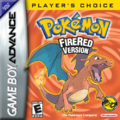
Player's Choice FireRed cover
-
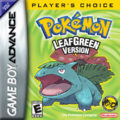
Player's Choice LeafGreen cover
Trivia
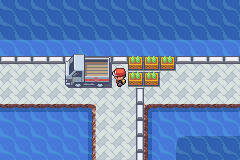
- The LeafGreen Pokédex entries are the same as those in the original Pokémon Red and Blue, as well as the Japanese Blue, for the Generation I Pokémon. The FireRed entries for the same Pokémon are the same as those in the original Pokémon Red and Green. This makes it the first time the original Red and Green entries have been translated into English.
- The truck, long rumored to have a Poké Ball containing Mew under it, appears again as scenery near the S.S. Anne. This time around, however, as an easter egg, there is a Lava Cookie hidden on the dock, which normally cannot be obtained until much later in the game.
- Along with the original Generation I games, these are the only core series games that do not involve a legendary Pokémon in their main plot.
- If a FireRed or LeafGreen cart is present in Slot 2 of the Nintendo DS, the migration option in the main menu of Pokémon Diamond and Pearl is incorrectly stated as "Migrate from Fire Red" or "Migrate from Leaf Green", with a space in the middle of the version names. This typo was fixed in Pokémon Platinum, HeartGold, and SoulSilver by removing the space.
- FireRed and LeafGreen are the last core series games to have no time-based features (since neither the console nor the cartridges have internal clocks), and the only ones to not have them since their introduction in Generation II.
- FireRed and LeafGreen are the only pair of core series remakes to date that were originally released for a system that could also play their original versions via backwards compatibility.
- Outside of trading or events, Wynaut is the only Generation III Pokémon that can be obtained in FireRed. This is the sole instance in the core series where only one Pokémon from a particular generation can be obtained in a game.
- In the end credits, the game mascots of the four Generation I games, Venusaur, Charizard, Blastoise, and Pikachu, appear with special 3-frame sprites, transforming from their in-game sprites to the pose they took on the Japanese boxart of their respective games. In the Japanese versions, they are inside a circle with the text THE POCKET MONSTER TRAINER, which is colored to match the Pokémon's type. In international versions, this is replaced by a Poké Ball symbol, also colored based on the Pokémon's type.
- The only Generation I Pokémon that cannot be encountered in these games is Mew, although this Pokémon was distributed in several events for the Generation III games.
 |  |  |  |
| Venusaur credits' sprite | Charizard credits' sprite | Blastoise credits' sprite | Pikachu credits' sprite |
 |  |  |  |
| Venusaur artwork from Pocket Monsters Green boxart | Charizard artwork from Pocket Monsters Red boxart | Blastoise artwork from Pocket Monsters Blue boxart | Pikachu artwork from Pocket Monsters Yellow boxart |
Typographical errors
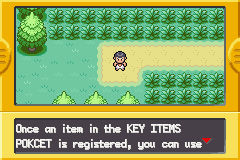
The Teachy TV error, showing "Pocket" as "Pokcet"
- Any category names with more than one word are cut off in early English releases of the games, causing for example Pokémon like Pidgey to be listed as "Tiny Pokémon" rather than "Tiny Bird Pokémon." Internal game data lists the categories the same as they appear in Pokémon Ruby, Sapphire, and Emerald and other games, indicating a mistake in the Pokédex where a blank space is misread for the terminating byte for the name. This was addressed in the later Player's Choice releases of the game. Alongside the missing word "Presents" in the game's opening, this is the easiest way to tell whether a particular game is a v1.0 or v1.1 release.
- In Teachy TV, during the program about registering items, the second instance of the word pocket in the phrase "Key Items Pocket" is misspelled as "Pokcet". This was not addressed in v1.1.
In other languages
| Language | Title | |
|---|---|---|
| | ポケットモンスターファイアレッド・リーフグリーン | |
| French | | Versions FireRed et LeafGreen de Pokémon* |
| | Pokémon Version Rouge Feu et Version Vert Feuille | |
| | Pokémon Feuerrote Edition und Blattgrüne Edition | |
| | Pokémon Versione Rosso Fuoco e Versione Verde Foglia | |
| | 포켓몬스터 파이어레드・리프그린 | |
| | Pokémon Edición Rojo Fuego y Edición Verde Hoja | |
See also
- FireRed and LeafGreen walkthrough
External links
Japan
- Pokémon.co.jp
- Nintendo.co.jp
United States
- Pokémon.com
United Kingdom
- Nintendo.co.uk (FireRed)
- Nintendo.co.uk (LeafGreen)
Australia
- Nintendo.com.au (Archived microsite - requires Flash Player)
References
- ↑ Pokémon.co.jp
- ↑ Pokémon.com (US)
- ↑ Pokémon.com (UK)
- ↑ 4.0 4.1 Trademarked title
- ↑ 5.0 5.1 Pokémon FireRed Version - IGN
- ↑ Pokemon FireRed Version Critic Reviews for Game Boy Advance - Metacritic
- ↑ Pokemon LeafGreen Version Critic Reviews for Game Boy Advance - Metacritic
- ↑ Nintendo Power magazine. Issue 184; page 123. October 2004.
- ↑ Pokémon LeafGreen/FireRed • Eurogamer.net
- ↑ Pokémon FireRed Version for Game Boy Advance - GameRankings (Archive)
- ↑ Pokémon LeafGreen Version for Game Boy Advance - GameRankings (Archive)
- ↑ FireRed and LeafGreen sell one million - GameSpot
- ↑ Nintendo Co., Ltd. - Annual Report 2004
- ↑ Pokémon X and Pokémon Y Sell More Than 4 Million Units Worldwide in First Two Days | Business Wire
- ↑ 『ポケモン赤・緑』がGBAで甦る!『ファイアレッド』『リーフグリーン』発売決定 - 電撃オンライン (earliest archived copy)
- ↑ 16.0 16.1 増田部長のめざめるパワー. August 30, 2004.
- ↑ 17.0 17.1 HIDDEN POWER of masuda. August 30, 2004.
- ↑ TGS 2003: Wireless GBA multiplayer for 2004 - Game Boy Advance News at GameSpot
- ↑ 19.0 19.1 E3 2004: The Pokemon Creators Speak - IGN
| Core series Pokémon games | ||||
|---|---|---|---|---|
| Generation I: | Red & Green • Blue (JP) • Red & Blue • Yellow | |||
| Generation II: | Gold & Silver • Crystal | |||
| Generation III: | Ruby & Sapphire • FireRed & LeafGreen • Emerald | |||
| Generation IV: | Diamond & Pearl • Platinum • HeartGold & SoulSilver | |||
| Generation V: | Black & White • Black 2 & White 2 | |||
| Generation VI: | X & Y • Omega Ruby & Alpha Sapphire | |||
| Generation VII: | Sun & Moon • Ultra Sun & Ultra Moon Let's Go, Pikachu! & Let's Go, Eevee! | |||
| Generation VIII: | Sword & Shield (Expansion Pass) Brilliant Diamond & Shining Pearl • Legends: Arceus | |||
| Generation IX: | Scarlet & Violet | |||
| Pokémon game templates | ||||
| ||||
greenhalghlaregrell.blogspot.com
Source: https://bulbapedia.bulbagarden.net/wiki/Pok%C3%A9mon_FireRed_and_LeafGreen_Versions


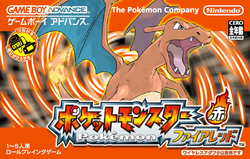
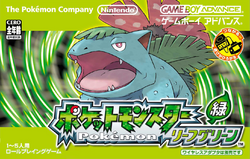

0 Response to "How to Continue After Elite Four in Pokemon Fire Red"
Post a Comment